Microstructure and Mechanical Properties of Hybrid AZ91 Magnesium Matrix Composite with Ti and SiC Particles
Abstract
:1. Introduction
2. Materials and Methods
3. Results and Discussion
4. Conclusions
- A new AZ91/(SiC + Ti)p hybrid composite was successfully fabricated by the relatively simple and inexpensive stir casting method;
- The microstructure of the obtained composite was characterised by uniform distribution of the Ti particles and microsegregation of some part of the SiC particles, although the rest of them were enclosed inside primary dendrites of the α phase. The microstructure of this material (besides the presence of reinforcing particles) consisted of dendrites of the primary α phase, α + γ eutectic and γDP discontinuous precipitates;
- The fabricated hybrid composite exhibited higher mechanical properties than the unreinforced matrix alloy. The fracture surface observations revealed that during the uniaxial tensile test, the cracking process of the composite proceeded mainly through the matrix phases.
Funding
Institutional Review Board Statement
Informed Consent Statement
Data Availability Statement
Conflicts of Interest
References
- Nishida, Y. Introduction to Metal Matrix Composites—Fabrication and Recycling, 1st ed.; Springer: Tokyo, Japan, 2013; pp. 165–179. [Google Scholar]
- Clyne, T.W.; Withers, P.J. An Introduction to Metal Matrix Composites, 1st ed.; Cambridge University Press: Cambridge, UK, 1993; pp. 370–398. [Google Scholar]
- Braszczyńska, K.N. Contribution of SiC particles to the formation of the structure of Mg-3 wt.% RE cast composites. Zeit. Metallkunde 2003, 94, 144–148. [Google Scholar] [CrossRef]
- Chawla, N.; Chawla, K.K. Metal Matrix Composites, 2nd ed.; Springer Science + Business Media: New York, NY, USA, 2013; pp. 97–119. [Google Scholar]
- Lagiewka, M.; Konopka, Z. The influence of graphite addition on the abrasive wear of AlMg10 alloy matrix composites reinforced with SiC particles. Arch. Foundry Eng. 2014, 14, 51–54. [Google Scholar] [CrossRef]
- Zarghami, M.; Emamy, M.; Malekan, M. Microstructure, mechanical properties and wear behaviour of the AZ91–Mg2Si–SiC hybrid composites. Mater. Sci. Technol. 2021, 37, 1333–1341. [Google Scholar] [CrossRef]
- Braszczyńska-Malik, K.N.; Kamieniak, J. Analysis of interface between components in AZ91 magnesium alloy foam composite with Ni-P coated fly ash cenospheres. J. Alloys Compd. 2017, 720, 352–359. [Google Scholar] [CrossRef]
- Dmitruk, A.; Naplocha, K.; Lagos, M.; Egizabal, P.; Grzęda, J. Microwave assisted self-propagating high-temperature synthesis of Ti3SiC2 MAX phase. Compos. Theory Pract. 2018, 18, 241–244. [Google Scholar]
- Lelito, J.; Zak, P.; Shirzadi, A.A.; Greer, A.L.; Krajewski, W.K.; Suchy, J.J.; Haberl, K.; Schumacher, P. Effect of SiC reinforcement particles on the grain density in a magnesium-based metal-matrix composite: Modeling and experiment. Acta Mater. 2012, 60, 2950–2958. [Google Scholar] [CrossRef]
- Ercetin, A.; Pimenov, D.Y. Microstructure, mechanical and corrosion behavior of Al2O3 reinforced Mg2Zn matrix magnesium composites. Materials 2021, 14, 4819. [Google Scholar] [CrossRef]
- Olszówka-Myalska, A.; Myalska, H.; Wrześniowski, P.; Chrapoński, J.; Cios, G. Application of nanosilicon to the sintering of Mg-Mg2Si interpenetrating phases composite. Materials 2021, 14, 7114. [Google Scholar] [CrossRef]
- Braszczynska-Malik, K.N.; Kamieniak, J. The role of Ni-P coating structure on fly ash cenospheres in the formation of magnesium matrix composites. Metall. Mater. Trans. A 2017, 48, 5649–5657. [Google Scholar] [CrossRef]
- Mitra, R.; Mahayan, Y.R. Interfaces in discontinuously reinforced metal matrix composites—An overview. Bull. Mater. Sci. 1995, 18, 405–434. [Google Scholar] [CrossRef]
- Orbulov, I.N.; Szlancsik, A.; Kemény, A.; Kincses, D. Low-cost light-weight composite metal foams for transportation applications. J. Mater. Eng. Perform. (JMEPEG) 2022, 1–8. [Google Scholar] [CrossRef]
- Baumli, P. Interfacial aspects of metal matrix composites prepared from liquid metals and aqueous solutions: A review. Metals 2020, 10, 1400. [Google Scholar] [CrossRef]
- Althahban, S.; Jazaa, Y.; Bafakeeh, O.; Alomari, A.S.; Sallam, H.E.-D.M.; Atta, M. The effect of reinforcement preheating temperatures on tribological behavior of advanced quranic metal-matrix composites (QMMC). Materials 2022, 15, 659. [Google Scholar] [CrossRef] [PubMed]
- Braszczynska, K.N.; Bochenek, A. The Young’s modulus (E) and fracture toughness (J(IC)) of MMCs reinforced with SiCP. Sci. Eng. Compos. Mat. 2000, 9, 149–158. [Google Scholar] [CrossRef]
- Iwaszko, J.; Kudła, K.; Fila, K. Technological aspects of friction stir processing of AlZn5.5MgCu aluminium alloy. Bull. Pol. Acad. Sci. Tech. Sci. 2018, 66, 713–719. [Google Scholar]
- Braszczyńska-Malik, K.N. Types of component interfaces in metal matrix composites on the example of magnesium matrix composites. Materials 2021, 14, 5182. [Google Scholar] [CrossRef]
- Pérez, P.; Garcés, G.; Adeva, P. Mechanical properties of a Mg-10 (vol. %)Ti composite. Compos. Sci. Technol. 2004, 64, 145–151. [Google Scholar] [CrossRef]
- Sankaranarayanan, S.; Jayalakshmi, S.; Gupta, M.; Abdelmagid, S.H. Influence of micron-Ti and nano-Cu additions on the microstructure and mechanical properties of pure magnesium. Metals 2012, 2, 274–291. [Google Scholar]
- Hassan, S.F.; Gupta, M. Development of ductile magnesium composite materials using titanium as reinforcement. J. Alloys Compd. 2002, 345, 246–251. [Google Scholar] [CrossRef]
- Meenashisundaram, G.K.; Gupta, M. Low volume fraction nano-titanium particulates for improving the mechanical response of pure magnesium. J. Alloys Compd. 2014, 593, 176–183. [Google Scholar] [CrossRef]
- Trojanová, Z.; Drozd, Z.; Lukáč, P.; Minárik, P.; Németh, G.; Seetharaman, S.; Džugan, J.; Gupta, M. Magnesium reinforced with Inconel 718 particles prepared ex situ—Microstructure and properties. Materials 2020, 13, 798. [Google Scholar] [CrossRef] [PubMed]
- Braszczyńska-Malik, K.N.; Przełożyńska, E. The influence of Ti particles on microstructure and properties of Mg-5Al-5RE matrix alloy composite. J. Alloys Compd. 2017, 728, 600–606. [Google Scholar] [CrossRef]
- Esen, Z.; Dikici, B.; Duygulu, O.; Dericioglu, A.F. Titanium-magnesium based composites: Mechanical properties and in-vitro corrosion response in Ringer’s solution. Mater. Sci. Eng. A 2013, 573, 119–126. [Google Scholar] [CrossRef]
- Raghunath, B.K.; Karthikeyan, R.; Ganesan, G.; Gupta, M. An investigation of hot deformation response of particulate-reinforced magnesium + 9% titanium composite. Mater. Des. 2008, 29, 622–627. [Google Scholar] [CrossRef]
- Braszczyńska-Malik, K.N.; Przełożyńska, E. Analyses of AM50-Tip metal-metal composite microstructure. J. Alloys Compd. 2018, 731, 1181–1187. [Google Scholar] [CrossRef]
- Guo, Y.C.; Nie, K.B.; Kang, X.K.; Deng, K.K.; Han, J.G.; Zhu, Z.H. Achieving high-strength magnesium matrix nanocomposite through synergistical effect of external hybrid (SiC + TiC) nanoparticles and dynamic precipitated phase. J. Alloys Compd. 2019, 771, 847–856. [Google Scholar] [CrossRef]
- Posmyk, A.; Myalski, J. Designing cylinder liners made from hybrid composites containing solid lubricants. Compos. Theory Pract. 2016, 16, 15–19. [Google Scholar]
- Braszczyńska-Malik, K.N. Magnesium Alloys and Composites on Their Matrix (Oryg. Title: Stopy Magnezu i Kompozyty na Ich Osnowie), 1st ed.; Czestochowa University Publisher: Częstochowa, Poland, 2017; pp. 82–133. ISBN 978-83-7193-674-6. (In Polish) [Google Scholar]
- Pitchayyapillai, G.; Seenikannan, P.; Raja, K.; Chandrasekaran, K. Al6061 hybrid metal matrix composite reinforced with alumina and molybdenum disulphide. Adv. Mat. Sci. Eng. 2016, 2016, 6127624. [Google Scholar] [CrossRef]
- Muley, A.V.; Aravindan, S.; Singh, I.P. Nano and hybrid aluminum based metal matrix composites: An overview. Manuf. Rev. 2015, 2, 15. [Google Scholar] [CrossRef]
- Zhang, C.; Fan, T.; Cao, W.; Ding, J.; Hang, D. Size control of in situ formed reinforcement in metal melts-theoretical treatment and application to in situ (AlN + Mg2Si)/Mg composites. Compos. Sci. Technol. 2009, 69, 2688–2694. [Google Scholar] [CrossRef]
- Naplocha, K.; Granat, K. Dry sliding wear of Al/Saffil/C hybrid metal matrix composites. Wear 2008, 265, 1734–1740. [Google Scholar] [CrossRef]
- Baradeswaran, A.; Elaya Perumal, A. Study on mechanical and wear properties of Al7075/Al2O3/graphite hybrid composites. Compos. Part B Eng. 2014, 56, 464–471. [Google Scholar] [CrossRef]
- Dolata, A.J.; Dyzia, M.; Boczkal, S. Influence of the Sr and Mg alloying additions on the bonding between matrix and reinforcing particles in the AlSi7Mg/SiC-Cgr hybrid composites. Arch. Metal. Mater. 2016, 61, 651–656. [Google Scholar] [CrossRef]
- Zhang, X.; Wang, H.; Liao, L.; Tang, X.; Ma, N. The mechanical properties of magnesium matrix composites reinforced with (TiB2 + TiC) ceramic particles. Mater. Lett. 2005, 59, 2105–2109. [Google Scholar]
- Trojanová, Z.; Gärtnerová, V.; Jäger, A.; Námešný, A.; Chalupová, M.; Palček, P.; Lukáč, P. Mechanical and fracture properties of an AZ91 Magnesium alloy reinforced by Si and SiC particles. Compos. Sci. Technol. 2009, 69, 2256–2264. [Google Scholar] [CrossRef]
- Umanath, K.; Palanikumar, K.; Selvamani, S.T. Analysis of dry sliding wear behaviour of Al6061/SiC/Al2O3 hybrid metal matrix composites. Compos. Part B Eng. 2013, 53, 159–168. [Google Scholar] [CrossRef]
- Zhang, X.; Geng, L.; Wang, G.S. Fabrication of Al based hybrid composites reinforced with SiC whisker and SiC nano particles by squeeze casting. J. Mater. Proc. Tech. 2006, 176, 141–151. [Google Scholar] [CrossRef]
- Wong, W.L.E.; Gupta, M.; Lim, C.Y.H. Enhancing the mechanical properties of pure aluminium using hybrid reinforcement methodology. Mater. Sci. Eng. A 2006, 423, 148–152. [Google Scholar] [CrossRef]
- Ge, D.; Gu, M. Mechanical properties of hybrid reinforced aluminium based composites. Mater. Lett. 2001, 49, 334–339. [Google Scholar] [CrossRef]
- Poovazhagan, L.; Kalaichelvan, K.; Rajadurai, A.; Senthilvelan, V. Characterization of hybrid silicon carbide and boron carbide nano particles reinforced aluminum alloy composites. Procedia Eng. 2013, 64, 681–689. [Google Scholar] [CrossRef]
- Feng, Y.C.; Geng, L.; Zeng, P.Q.; Zeng, Z.Z.; Wang, G.S. Fabrication and characterization of Al based hybrid composite reinforced with tungsten oxide particles and aluminium borate whisker by squeeze casting. Mater. Des. 2008, 29, 2023–2026. [Google Scholar] [CrossRef]
- Reddy, B.S.B.; Rajsekar, K.; Venu, M.; Dilip, J.S.S.; Das, S.; Das, K. Mechanical activation assisted solid-state combustion synthesis of in situ aluminium matrix hybrid (Al3Ni/Al2O3) nano composite. J. Alloys Compd. 2008, 465, 97–105. [Google Scholar] [CrossRef]
- Fan, G.H.; Geng, L.; Zeng, Z.Z.; Wang, G.S.; Zeng, P.Q. Preparation and characterization of Al18B4O33 + BaPbO3/Al hybrid composite. Mater. Lett. 2008, 62, 2670–2672. [Google Scholar] [CrossRef]
- Vijay, P.; Brahma Raju, K.V.; Ramji, K.; Kamaluddin, S. Effect of tungsten carbide on Al6061/SiC hybrid metal matrix composites. Compos. Theory Pract. 2021, 21, 169–180. [Google Scholar]
- Feng, Y.C.; Geng, L.; Fan, G.H.; Li, A.B.; Zeng, Z.Z. The properties and microstructure of hybrid composites reinforced with WO3 particles and Al18B4O33 whiskers by squeeze casting. Mater. Des. 2009, 30, 3632–3635. [Google Scholar] [CrossRef]
- Kumar, D.R.; Narayanasamy, R.; Loganathan, C. Effects of glass and SiC in aluminum matrix on workability and strain hardening behaviour of powder metallurgy hybrid composites. Mater. Des. 2012, 34, 120–136. [Google Scholar] [CrossRef]
- Braszczyński, J.; Cisowska, M.; Braszczyńska, K. Hybrid composite aluminium alloy − (SiC + Cgr) abrasive wear-resistant particles. Acta Metall. Slovaca 1999, 5, 473–477. [Google Scholar]
- Guan, L.; Geng, L.; Zhang, H.; Huang, L. Effects of stirring parameters on microstructure and tensile properties of (ABOw + SiCp) 6061 Al composites fabricated by semi-solid stirring technique. Trans. Nonferr. Met. Soc. China 2011, 21, 274–279. [Google Scholar] [CrossRef]
- Łągiewka, M.; Konopka, Z.; Zyska, A. Solidification of hybrid composites AlMg10/SiC + Cgr. Arch. Foundry Eng. 2006, 6, 325–330. [Google Scholar]
- Geng, L.; Zhang, X.; Wang, G.; Zheng, Z. Effect of aging treatment on mechanical properties of (SiCw + SiCp)/2024 Al hybrid nano composite. Trans. Nonferr. Met. Soc. China 2006, 16, 387–391. [Google Scholar] [CrossRef]
- Reddy, G.C.; Rajkumar, K.; Aravindan, S. Fabrication of copper-TiC-graphite hybrid metal matrix composites through microwave processing. Int. Adv. Manuf. Technol. 2010, 48, 645–653. [Google Scholar]
- Zygmuntowicz, J.; Łukasiak, A.; Piotrkiewicz, P.; Kaszuwara, W. Al2O3-Cu-Mo hybrid composites: Fabrication, microstructure, properties. Compos. Theory Pract. 2019, 19, 43–49. [Google Scholar]
- Deng, K.; Shi, J.; Wang, C.; Wang, X.; Wu, Y.; Nie, K.; Wu, K. Microstructure and strengthening mechanism of bimodal size particle reinforced magnesium matrix composite. Compos. Part A 2012, 43, 1280–1284. [Google Scholar] [CrossRef]
- Kondoh, K.; Kawakami, M.; Imai, H.; Umeda, J.; Fujii, H. Wettability of pure Ti by molten pure Mg droplets. Acta Mater. 2010, 58, 606–614. [Google Scholar] [CrossRef]
- Yang, X.; Wang, F.; Fan, Z. Crystallographic study of nucleation in SiC particulate reinforced magnesium matrix composites. J. Alloys Compd. 2017, 706, 430–437. [Google Scholar] [CrossRef]
- Wu, K.; Zheng, M.; Yao, C.; Sato, T.; Tezuka, H.; Kamio, A.; Li, D.X. Crystallographic orientation relationship between SiC and Mg in squeeze-cast SiC/Mg composites. J. Mater. Sci. Lett. 1999, 18, 1301–1303. [Google Scholar] [CrossRef]

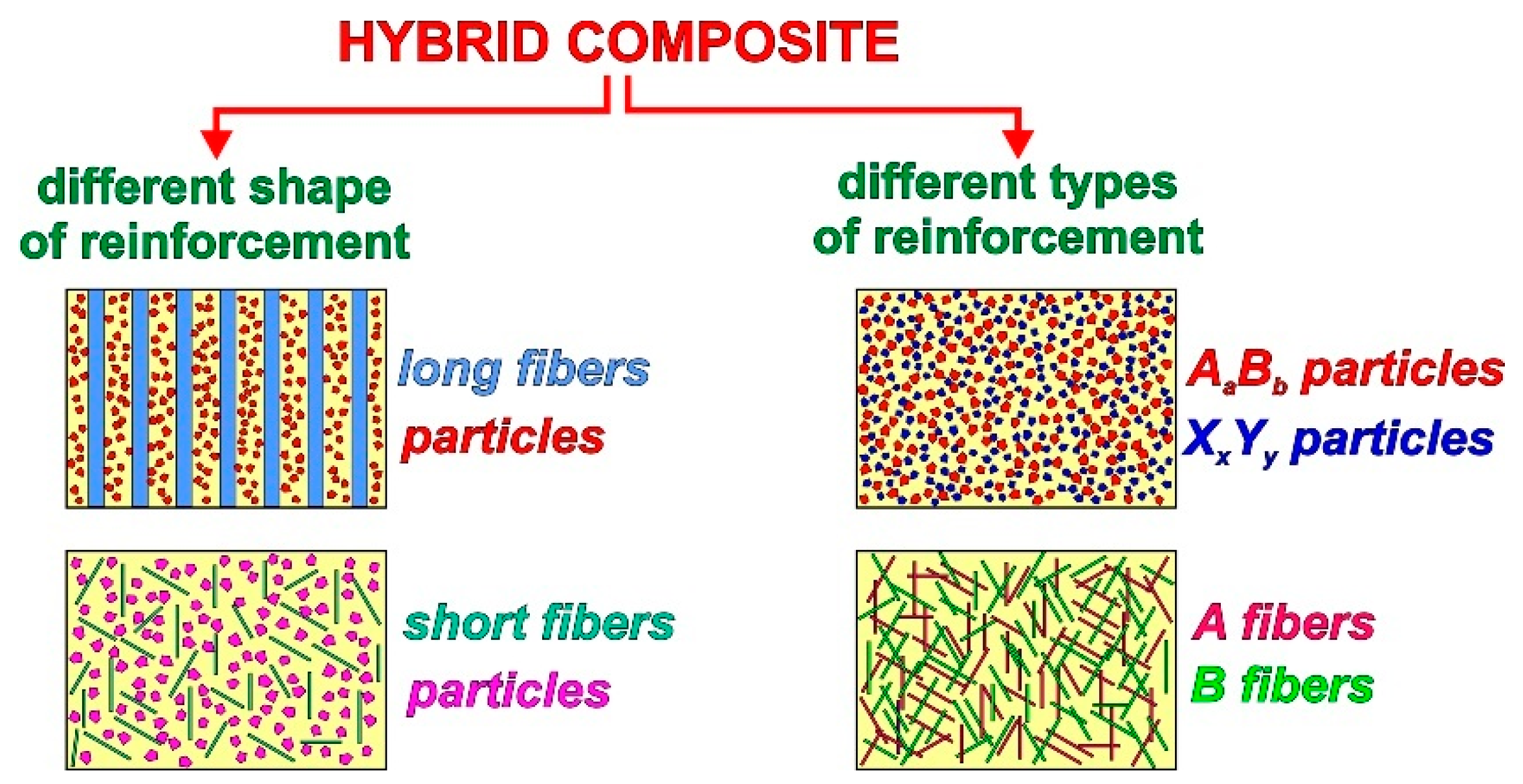
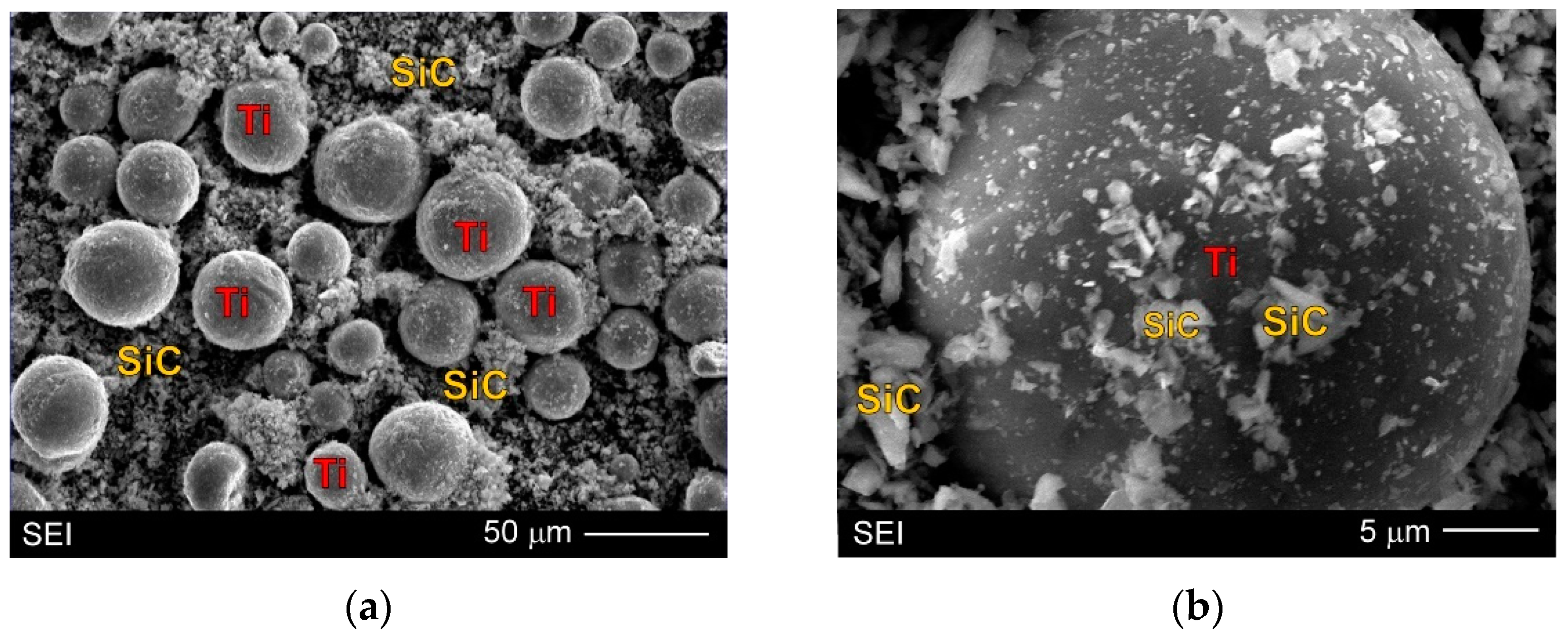


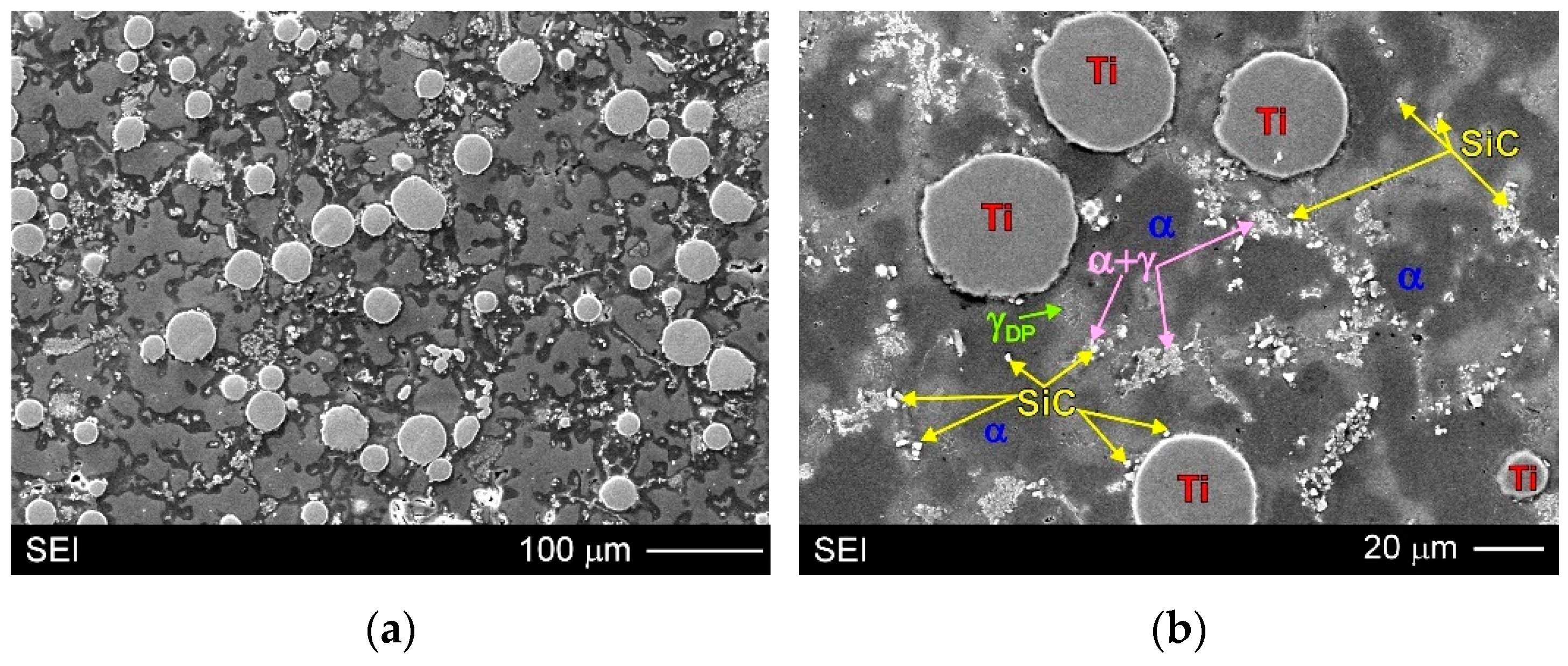

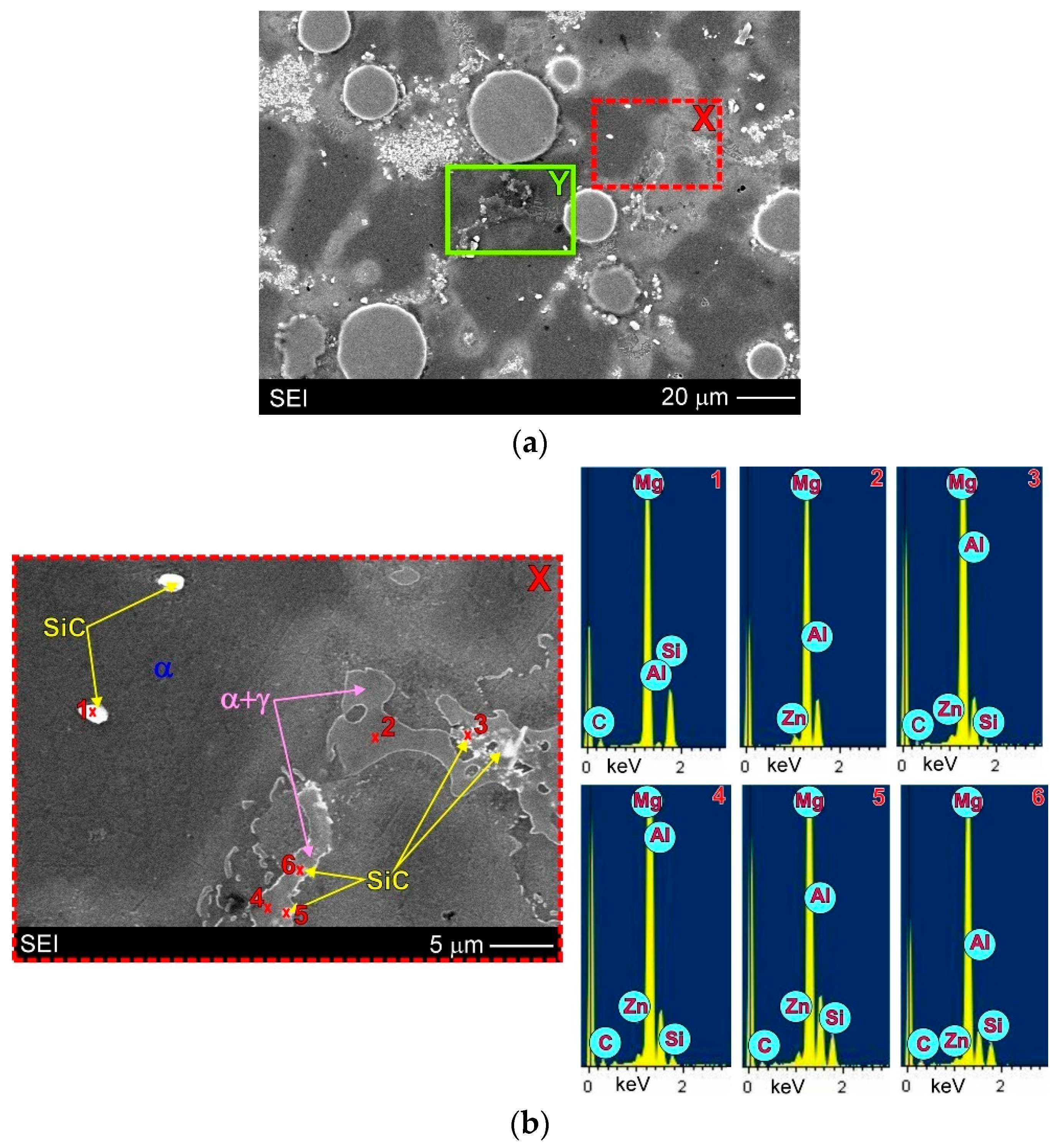
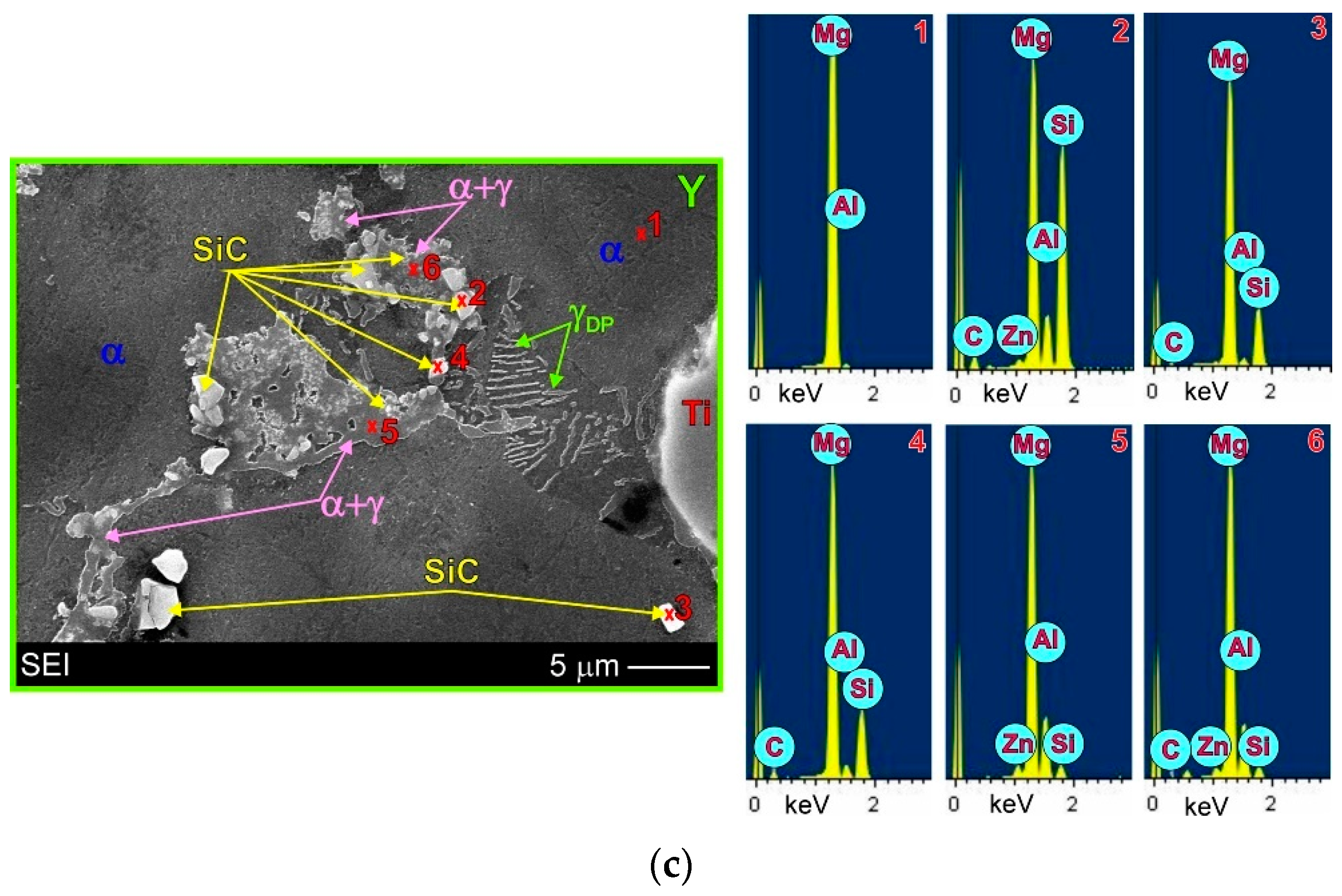

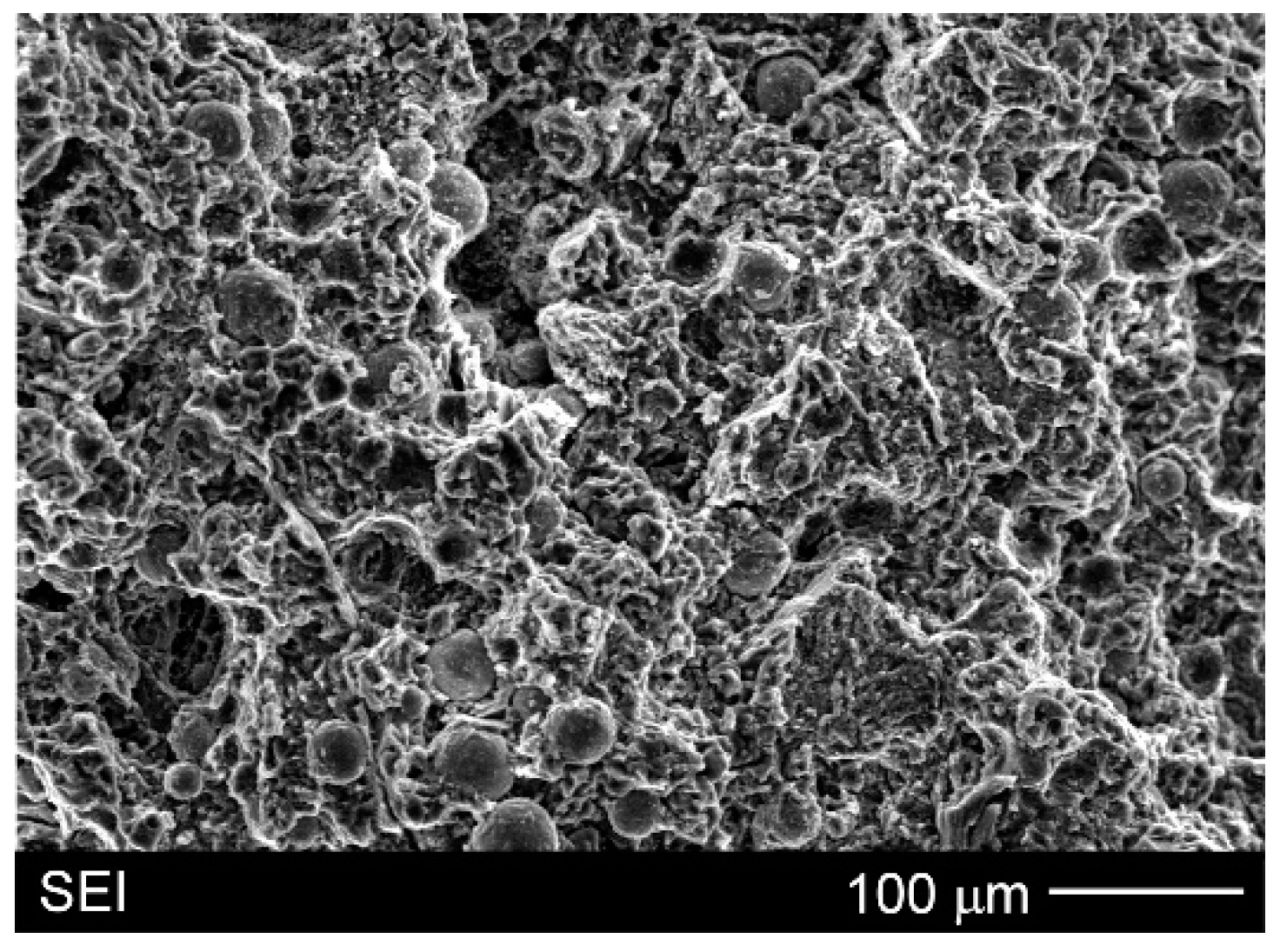
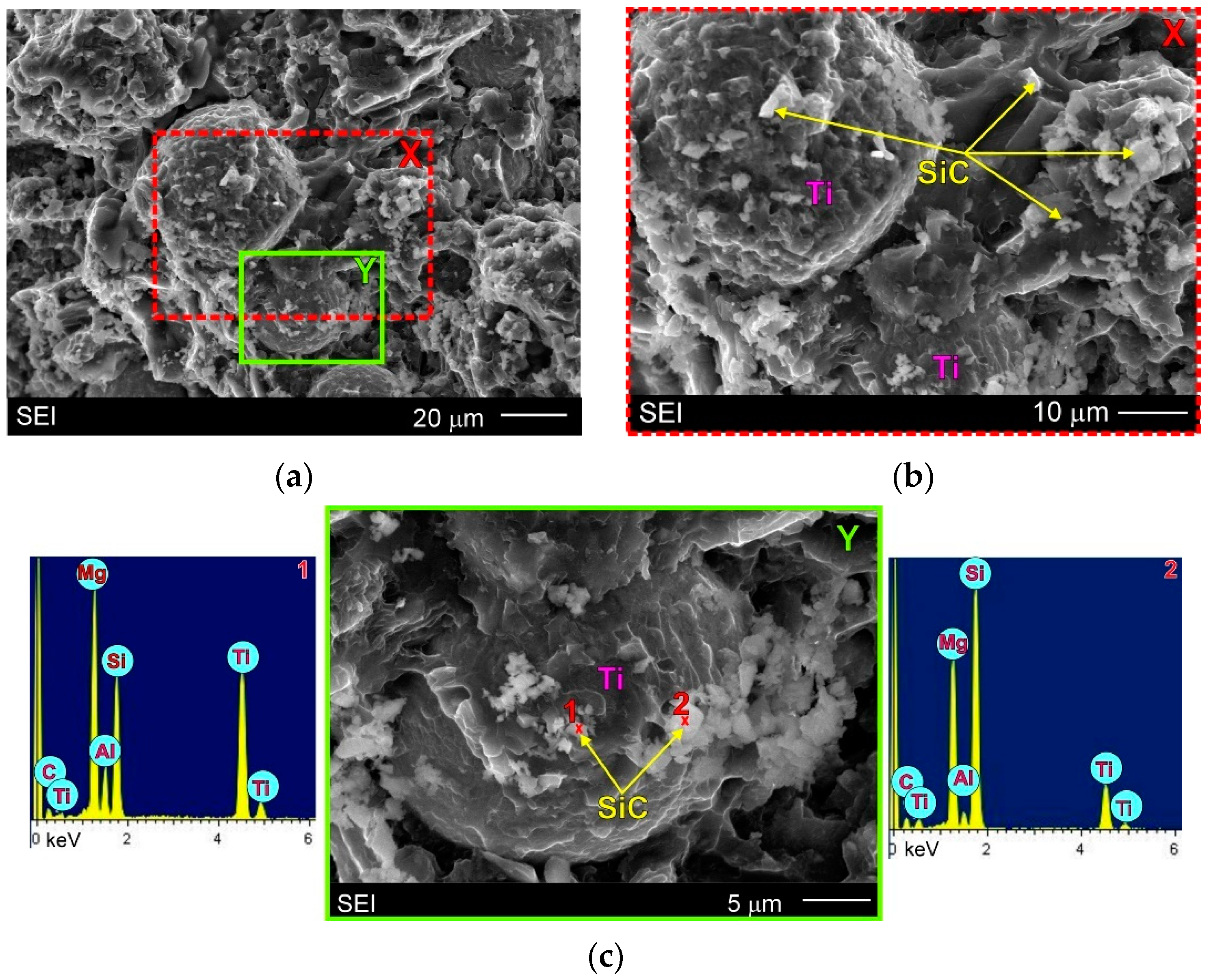
| Alloy | Chemical Composition wt.% | |||
|---|---|---|---|---|
| Al | Zn | Mn | Mg | |
| AZ91 | 8.7 | 0.7 | 0.13 | rest |
| Material | UTS | TYS | CS | YS |
|---|---|---|---|---|
| AZ91/(Ti + SiC)p composite | 141 | 118 | 351 | 175 |
| AZ91 matrix alloy | 117 | 89 | 315 | 147 |
Publisher’s Note: MDPI stays neutral with regard to jurisdictional claims in published maps and institutional affiliations. |
© 2022 by the author. Licensee MDPI, Basel, Switzerland. This article is an open access article distributed under the terms and conditions of the Creative Commons Attribution (CC BY) license (https://creativecommons.org/licenses/by/4.0/).
Share and Cite
Braszczyńska-Malik, K.N. Microstructure and Mechanical Properties of Hybrid AZ91 Magnesium Matrix Composite with Ti and SiC Particles. Materials 2022, 15, 6301. https://doi.org/10.3390/ma15186301
Braszczyńska-Malik KN. Microstructure and Mechanical Properties of Hybrid AZ91 Magnesium Matrix Composite with Ti and SiC Particles. Materials. 2022; 15(18):6301. https://doi.org/10.3390/ma15186301
Chicago/Turabian StyleBraszczyńska-Malik, Katarzyna N. 2022. "Microstructure and Mechanical Properties of Hybrid AZ91 Magnesium Matrix Composite with Ti and SiC Particles" Materials 15, no. 18: 6301. https://doi.org/10.3390/ma15186301
APA StyleBraszczyńska-Malik, K. N. (2022). Microstructure and Mechanical Properties of Hybrid AZ91 Magnesium Matrix Composite with Ti and SiC Particles. Materials, 15(18), 6301. https://doi.org/10.3390/ma15186301





